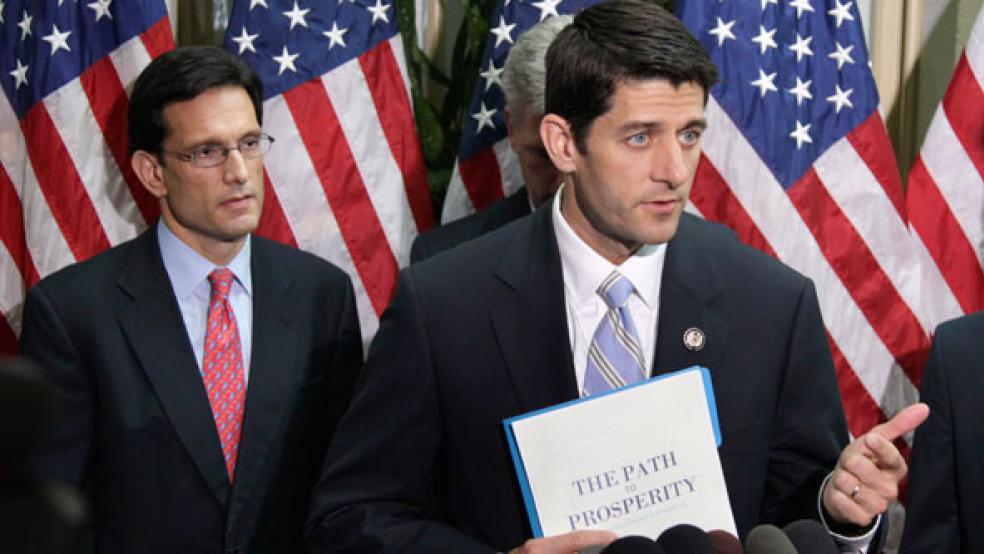GOP House Budget Committee Chairman Paul Ryan’s new budget plan slashes spending, overhauls and reduces tax rates, and adds an optional private insurance option to the Medicare system. It’s the talk of Washington and will likely influence the campaign debate this year.
The proposal also calls for reducing domestic spending below the cap agreed to last summer by the Obama administration and congressional leaders. While the 98-page document, “The Path to Prosperity, A Blueprint for American Renewal,” will come under intense scrutiny from both sides of the political aisle, here are five things you should keep in mind about the Ryan plan as Congress and the White House wrangle over a new fiscal 2013 budget blue print:
1) It’s a Likely Big Revenue-Loser
Although Ryan says he will “broaden the tax base to maintain revenue,” his tax overhaul would create a steep revenue loss for the Treasury in the neighborhood of $4.6 trillion by 2022, according to estimates from the Tax Policy Center. The shortfall would result from retooling individual tax brackets to 2, at and 25 percent, repealing the Alternative Minimum Tax, repealing tax provisions in the health care law, and moving the U.S. from a worldwide system of taxation to a territorial one, which would mostly exempt multinational corporations’ foreign profits from U.S. taxes. If the Bush-era tax cuts are made permanent, as Ryan is also proposing, overall revenue losses by 2022 could swell to $10 trillion, the Tax Policy Center found.
However, Ryan’s plan includes tax measures that he says would make the plan “revenue neutral” because Congress would offset those mega revenue losses by eliminating scores of costly tax breaks and loopholes. But he has declined to mention any likely targets, such as the home mortgage interest deduction or the tax break on employer provided health care – two of the largest tax expenditures. Ryan said it would be up to the tax-writing House Ways and Means Committee to decide.
2) It Would Take nearly 30 Years to Balance the Budget
Ryan’s budget seeks to eliminate deficits and pay down the national debt by 2040—first by pushing deficits below 3 percent of GDP by 2015 through mostly cuts to Medicare and Medicaid. In contrast, President Obama’s 2013 budget accrues deficits equal to 5.5 percent of GDP.
While many conservatives agree with Ryan’s underlying themes, some say his plan takes far too long to balance the budget. The conservative Club for Growth criticized the proposal for taking “decades” to balance the budget, despite noble intentions.
According to Ryan, the Congressional Budget Office estimates used to formulate these figures likely slow down the timing to reach a balanced budget. “We believe these numbers actually underestimate how much better off this budget puts our fiscal condition,” Ryan said Tuesday in a press conference at the American Enterprise Institute. “If you applied more reasonable growth assumptions,” including an extension of the Bush-era tax cuts, “you would reach balance and debt payoff far faster than what CBO here shows.”
3) It Alters Part of Last Summer’s Debt Ceiling Deal
By setting a $1.028 trillion discretionary spending cap for fiscal 2013, Ryan’s plan would alter the framework of last summer’s debt ceiling compromise by adding $19 billion more in program cuts. House and Senate Democratic leaders have complained that Ryan’s plan amounts to “a breach of faith” that will make it more difficult to negotiate further agreements.” House Speaker Boehner, R-Ohio, has dismissed these complaints, insisting that the agreed upon cap was merely an “upper limit” on discretionary spending, and that lowering it further is permissible under the law. “People have limits on credit cards. That doesn’t mean that you’re required to spend up to the limit,” Boehner told reporters Tuesday.
4) It Could Leave More People Uninsured
According to a preliminary Congressional Budget Office analysis of Ryan’s health care proposals, a “much higher” number of people would be without health insurance under his plan because it would repeal Obama’s signature health care reform, which is designed to extend insurance coverage to more than 30 million Americans.
CBO also found that by 2030, when the entire baby boom generation is eligible, government spending on each new Medicare recipient would be about $2,000 less, adjusted for inflation, than under the current plan. A more comprehensive CBO review of last year’s Republican budget proposal that largely mirrored this year’s, concluded that insurers and senior citizens would end up paying on average an additional $500 per year in out-of-pocket medical costs.
5) Conservatives Aren’t Sold on It
Though Republican presidential frontrunner Mitt Romney and conservatives widely lauded Ryan’s overall framework of lowering taxes, cutting spending, and reining in health care costs, many expressed dissatisfaction with the specifics.
A panel of Republican lawmakers told reporters at the Heritage Foundation Tuesday they were dissatisfied with Ryan’s proposed $5.3 trillion in spending cuts over ten years and $1.028 trillion spending cap, deriding both as too modest to balance the budget quickly.
“I appreciate so much the great work of Paul Ryan. But we took a pledge, and we said we could cut more than is being cut,” said Rep. Louie Gohmert, R-Texas. Rep. Tim Huelskamp complained the proposal was “not good enough,” noting that it wasn’t as tough as spending cut provisions of the GOP’s 2010 “Pledge to America”.
Similarly, GOP presidential contender Rick Santorum said Tuesday the plan would take too long to scale back entitlement spending and implement Medicare reform. “We need to move forward quicker,” he said.






